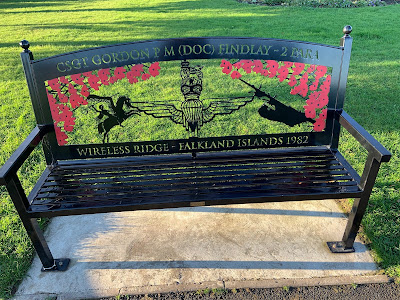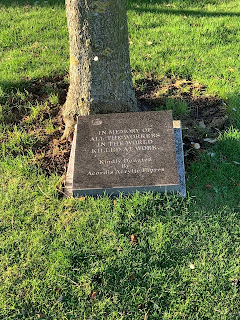We had a second trip to Cleethorpes recently, and on Friday morning I took a stroll out from the house where we were staying. The sky was clear and the air still and cool. Perfect weather really. In the area known as High Cliff (which in fact is a low clay cliff, but higher than the surrounding land*) is a memorial to all the UK armed forces. The town plays host to parades on Armed Forces Day and this is the focal point at the end of the parade.
* Aside. In the early19th century the fishing village of Cleethorpes had become a resort, for presumably the relatively well-off as travel was by horse-drawn carriage. Much of the town's seafront was a low clay cliff, which was subject to erosion much like those on the Holderness coast of Yorkshire. By mid-century a railway had been built to neighbouring Grimsby, where the railway company had seen an opportunity and expanded the docks. So they built a railway and expanded the reason for building it to make sure it was successful! This was working so well that in the 1860s the railway company repeated the trick. As well as expanding the railway the couple of miles to Cleethorpes, they built the first part of the Promenade. As well as providing a place to perambulate (adding to the amenity of the place and encouraging more railway traffic), the promenade acted as a bulwark for the cliffs, preventing further erosion. That made the buildings in the old part of town safe too. Visionary stuff.
This is very near the Royal Air Forces Association building, and in front of that in the Pier Gardens is a memorial statue to the RAF. This being Lincolnshire, there is a big association with Bomber Command.
 |
| Note the 's' in 'Forces'. The building also hosts the local branch of the Parachute Regiment Association. |
 |
| The RAF memorial, currently undergoing renovation. |
These memorials I've known about, though both were installed in relatively recent times. A few paces further along in the gardens I came across a few new memorials.
 |
| Bench installed in honour of Colour Sergeant Findlay of 2nd battalion the Parachute Regiment ('2 Para') killed in the Falklands War. A couple of links can be found below. |
 |
| A few yards away is this bench in honour of the 2nd battalion, the Royal Anglian Regiment. |
The Royal Anglians are one of those multi-battalion regiments created following the mergers of county (infantry) regiments, in this case from Eastern England. 2 RAR incorporates the former Royal Lincolnshire Regiment (10th Foot), hence the nickname of the Poachers. The 'local' cavalry regiment was the 17th/21st Lancers, since subject to two further mergers, the last being in 2015. It's sad to note the flowers left on the bench, clearly indicating a loss in relatively recent times.
Across the way from the gardens, on Alexandra Road is a modern Baptist church. This replaced the earlier Baptist church that was hit by a bomb dropped by a Zeppelin in 1916. The church hall was temporarily being used to accommodate soldiers of the Manchester Regiment who had been sent to the area to help protect the Humber. Twenty-seven soldiers were killed outright with a further four dying of their wounds.
 |
| Plaque tucked away on the side of the church. Links about this incident below. |
http://friendsofcleethorpesheritage.co.uk/home/alan-dowling-articles/cleethorpesandthezeppelinraid
https://livesofthefirstworldwar.iwm.org.uk/community/2933
Two final memorials lie in this area. Both civilian. The author of the article on the Cleethorpes Heritage website, Dr Alan Dowling, was librarian at Grimsby Central Library and had a couple of books published on local history. One on the development of Grimsby and a companion book on the development of Cleethorpes. Both are excellent examples of good local history - not the usual collections of photos of 'bygones' that you get in local bookshops. On a bench close to the Poachers' bench is one with a plaque to the good doctor.
The other is a memorial to a much broader group of people. Those who lost their life at work.
All of these can found in an area 120 x 50 yards. See map below.
 |
| The buildings to the right of the church are the council offices also hit in the Zeppelin raid. The third bomb fell in the street 2nd to right (Sea View Street). |
I'm glad that all these people referred to have been remembered in this way.





Some interesting history in a small area 👍
ReplyDeleteA good decision by the council and various stakeholders to have the memorials in that specific location. And looking out to sea.
DeleteSome very nice memorials there, with the benches being particularly nice. A timely reminder at this time of year of the sacrifices made by so many, both at home and abroad.
ReplyDeleteThe Royal Naval Association Club used to be next door to the RAF club. Is it still there?
ReplyDeleteTony S
Good point. I’m ashamed to say I forgot that.
DeleteIf you look closely at the ground floor window of the building to the left of the Air Force Association you can just about see a sign. On Street View you can read the sign as being that of the RN Association. It’s nothing like as prominent as the Air Force one.
Another interesting post. Never knew about the Zeppelin raid but I’m going to do a bit more research since L22 quoted as having caused the damage crashed in 1914?!
ReplyDeleteThanks old fruit. Would love to know how you get on.
DeleteDid a bit of digging around. The German army and navy both operated zeppelins. The army LZ 22 did indeed crash in 1914 but the navy’s L22 is the one that bombed the town and whose fate is recorded below.
DeleteOn May 14th, 1917, the L-22 was shot down by a British Curtiss flying boat H-12 (Cdr. Robert Leckie, No.8666 from Great Yarmouth), 40 miles NW of Terschelling, North Sea. Read more at wrecksite: https://www.wrecksite.eu/wreck.aspx?291941
Outstanding! Thanks for that. I wasn’t aware of that site.
DeleteNice ,timely collection of memorials!
ReplyDeleteBest Iain
The date didn’t occur to me at first. Serendipity. It was a spontaneous decision to go for a walk. Sort of fitted with why I was there.
DeleteThe UK is so full of history, even in quiet places where you dont necessarily expect to find it, that it definitely pays to keep your eyes open for these types of things - thanks for sharing them with us!
ReplyDeleteYou’re welcome Keith. There must be thousands and thousands of things with stories to tell all round the country.
Delete